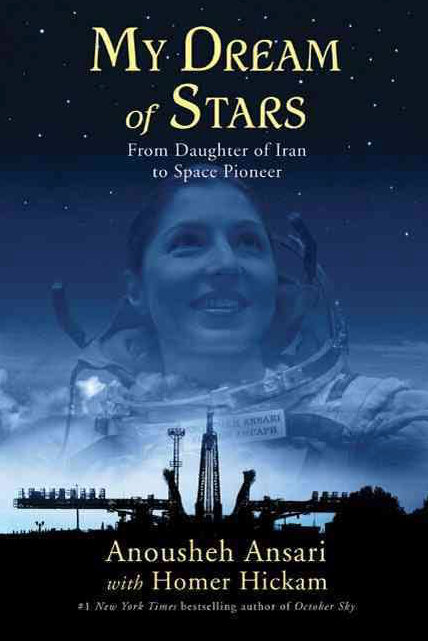Anousheh Ansari: An Astronomical Life
A young girl with dark curly hair dreamt of travelling to outer space. She would make the most of clear nights stargazing from her balcony, enthralled by the sheer mystery of space, wondering what’s out there, what’s it like and how she could get there.
She lived her dream for 11 days and returned to earth to tell the tale.
The First Female Private Explorer and First Space Ambassador
Dr Anousheh Ansari was the first self-funded woman in history to fly into space. She is also the first astronaut of Iranian descent and the first Muslim woman space explorer as well as the first to post blogs while orbiting the universe.
The Iranian scientist has achieved these – and more – despite the stigma of deeply entrenched cultural, racial and gender discrimination against women.
“When I was young I made the decision I wanted to be an astronaut / astrophysicist and travel into space,” recalls the Iranian-American, who became only the fourth private explorer to visit space.
On board the modular space station International Space Station (ISS), which moves at the speed of 17,500 miles (approx. 28,163.5 kms) per hour and makes a full rotation around the earth once every 90 minutes, the out-of-this-world experience left her breathless.
“Each day I was able to see 16 sunsets and 16 sunrises. Every morning when I woke up I had to remind myself that I was not dreaming,” she says.
On September 18, 2006, just six days after she turned 40, her dream finally came true.
Nothing prepared her for those awe-inspiring 11 days in space. And please… don’t call her a space tourist. It undermines her role in the mission. It also trivialises the historic and personal record she has achieved during her astronomical journey through life.
Anousheh Ansari: Being a woman should not make any difference. It should just be proof that both women and men can equally enjoy a trip to space. (Image: Straits Times, 20 July 2021)
The intensive six-month preparations took place at Star City in Russia. It included classroom training, simulator training, zero gravity and survival techniques, the same training received by astronauts, but while her training was at “user” level, they (astronauts) undergo around two years’ more of in-depth training. She had to take an active role as crewmember.
She thought she’d be really nervous the day of the flight but was surprised to see that she wasn’t. She stepped on board Expedition 14, which had a capacity for only three crew members, including her. It took two days to travel to the ISS. She spent eight days on the ISS before returning to earth.
“It was actually very Zen-like waiting for the moment when my dream would come true,” she remembers. “We spent two-and-a-half-hours in the capsule preparing launch procedures. After that, they put some music on and we had a chance to relax.”
The ISS has about 1,500 cubic feet of space, which is the same square footage as a three-bedroom apartment. It weighs about 454,240 pounds (approx 206,039.7 kilos or the weight of 40 elephants).
It doesn’t take very long to get out of the earth’s atmosphere, but the journey required circling the earth to get to the appropriate orbit for docking on the ISS.
“The feeling of weightlessness was the most incredible thing about the trip. Nothing compares to the absolute freedom I felt when I could literally fly across the room and propel myself with the gentle push of a single finger.
She lived her astronomical dream at 40 and returned to earth to tell the tale
View of planet earth from the other side
“Seeing Earth from the Space Station changed my perception of the planet and made me feel much more protective of this precious gift that we have to look after. I didn’t want to go back and even considered hiding on board the ISS, although I did miss my husband and family very much by then!”
Anousheh knows that her space flight dream wouldn’t have happened had she not moved to the USA when she was a teenager.
Born on September 12, 1966 in Mashhad, the second most populous city in Iran, her family moved to Tehran shortly after her birth. Anousheh grew up engulfed by the turmoil of the Iranian Revolution in the late 1970s.
Her father lost his job when the revolution escalated. It made life more difficult for the family. She was also getting closer to university age and, given the political unrest, her choices of a university degree was very limited in Iran. An aunt lived in the USA so a 16-year-old Anousheh landed in America without speaking a word of English.
It was the first time she had left Iran. Blending in wasn’t easy. But she was resolute that she must work hard to learn English and choose her field of study.“I know that at the time wanting to be an engineer, for a girl, was considered being a geek. I love physics. My favourite subjects were math and physics,” smiles Anousheh, who is fluent in Persian, English, French and acquired a working knowledge of Russian for her space flight adventure.
“The U.S. is a mecca for technology. There is so much opportunity… and I have worked hard to take advantage of those opportunities to achieve my dreams,” says Anousheh, who was the first in her family to go into the science, math and technology field.
People look at me and see that I’m a regular person. That allows them to understand that flying to space is also possible for them.
Anousheh, who holds dual nationalities (Iranian and American), received her Bachelor of Science degree in Electrical Engineering and Computer Science at George Mason University in Fairfax, Virginia in 1989, and her Master's degree at George Washington University in D.C. in 1992 as well as two honorary Doctor of Science degrees from Utah Valley University, and International Space University.
“I’m a U.S. citizen who was born in Iran. Both countries are part of who I am. My roots are in Iran, and America has given me the opportunities that I would have never had in Iran and made it possible for me to realize my dream. In particular, my Iranian heritage instilled a focus on education and a strong work ethic into my everyday life,” she says.
Interview with the writer, Singapore 2015
After graduation, Anousheh joined American telecommunications firm MCI, where she met her future husband, Hamid Anousheh. They were married in 1991.
“My husband and I both launched our careers at MCI, where we gained incredible hands-on experience in the telecommunications industry. Then we saw a great opportunity to launch our own telecommunications venture,” she says, adding that she first developed an interest in telecommunications while in college.
In 1994, the entrepreneurial couple invested all their savings to establish Telecom Technologies, Inc (TTI). The company eventually developed a “softswitch” that enabled voice communications over the Internet.
By 2001, Telecom Technologies owned three key U.S. patents and had 250 employees. The time was right for a merger with Sonus Networks, Inc, which offered the opportunity to grow the capabilities of the technology. The merger with Sonus (Nasdaq: SONS), a provider of IP-based voice infrastructure products, was worth approximately US$750 million.
Despite the windfall her dream of flying to outer space never left her.
“I never lost that passion even as I grew older and continued on into my business life. Once Dennis Tito started talking about buying a trip to space on the Russian Soyuz spacecraft in the 1990s, I decided to work really hard at my business and, if all else failed, I could buy a ticket!” she thought. (Tito is the American engineer and multimillionaire who became the first self-funded space tourist in mid-2001.)
The space flight aspiration prompted her and her family to set up the Anousheh X Prize in 2004, a space competition initiative that altered the trajectory of human space flight.
“My family worked with the X Prize Foundation to provide title sponsorship for the Anousheh X Prize. Together, we awarded US$10 million for the first non-governmental organization to launch a reusable manned spacecraft into space twice within two weeks,” says the CEO of the X Prize Foundation, Inc.
Inspiring girls to reach for the stars, chase their dream no matter how lofty it may seem
Her space flight achievement has provided her a platform to deliver her message – “to reach for the stars” – to a wider global audience regardless of gender. She doesn’t think being a woman should make any difference. It should just be proof that both women and men can equally enjoy a trip to space.
She is constantly working toward enabling social entrepreneurs to bring about radical change globally with non-profit organisations such ASHOKA (supports social entrepreneurship around the world, including the Middle East and Central Asia); and the PARSA Community Foundation (promotes strategic philanthropy and social entrepreneurship among the global Iranian community.)
I met Anousheh in person in 2015 when she was here for the Singapore Committee for UN Women’s efforts to end human trafficking in the Asia region. She shared her journey from daughter of war-torn Iran to space pioneer. Her story is a testament to the power of conviction, commitment and unwavering focus.
Also during the same trip, she was a guest speaker at an exclusive lunch hosted by Women On A Mission where she talked about women empowerment to help raise awareness and funds for women survivors of war and abuse.
Anousheh also addressed secondary school youth of Singapore as part of their Science, Technology, Engineering and Math (STEM) programme aimed at inspiring girls to embark on worthy careers in science, technology, engineering and mathematics.
“I think my trip put a more public face on space, especially for women. People look at me and see that I’m a regular person. That allows them to understand that flying to space is also possible for them,” says the First Female Private Explorer and First Space Ambassador.
It seems like a lifetime ago when Dr Anousheh Ansari realised her astronomical dream and made history. She published her memoir, My Dream of Stars, to inspire people, especially women and girls, to reach for the stars, chase their dream no matter how lofty it may seem.
Debbie | ws
XPRIZE Foundation Inc. | Dr. Anousheh Anousheh | ASHOKA | PARSA








